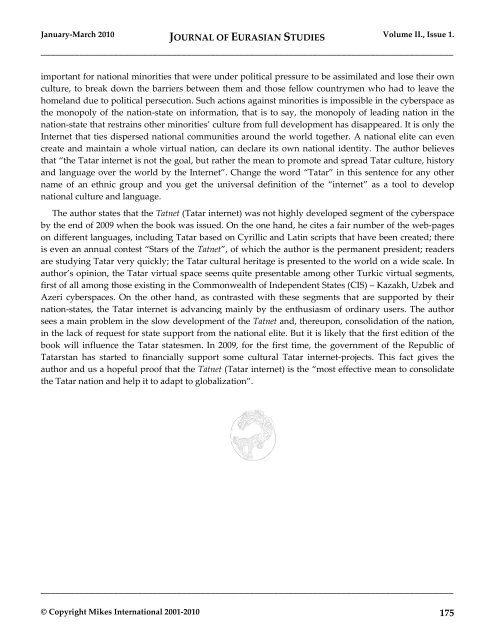EurasianStudies_0110..
EurasianStudies_0110..
EurasianStudies_0110..
You also want an ePaper? Increase the reach of your titles
YUMPU automatically turns print PDFs into web optimized ePapers that Google loves.
January-March 2010 JOURNAL OF EURASIAN STUDIES Volume II., Issue 1.<br />
_____________________________________________________________________________________<br />
important for national minorities that were under political pressure to be assimilated and lose their own<br />
culture, to break down the barriers between them and those fellow countrymen who had to leave the<br />
homeland due to political persecution. Such actions against minorities is impossible in the cyberspace as<br />
the monopoly of the nation-state on information, that is to say, the monopoly of leading nation in the<br />
nation-state that restrains other minorities’ culture from full development has disappeared. It is only the<br />
Internet that ties dispersed national communities around the world together. A national elite can even<br />
create and maintain a whole virtual nation, can declare its own national identity. The author believes<br />
that “the Tatar internet is not the goal, but rather the mean to promote and spread Tatar culture, history<br />
and language over the world by the Internet”. Change the word “Tatar” in this sentence for any other<br />
name of an ethnic group and you get the universal definition of the “internet” as a tool to develop<br />
national culture and language.<br />
The author states that the Tatnet (Tatar internet) was not highly developed segment of the cyberspace<br />
by the end of 2009 when the book was issued. On the one hand, he cites a fair number of the web-pages<br />
on different languages, including Tatar based on Cyrillic and Latin scripts that have been created; there<br />
is even an annual contest “Stars of the Tatnet”, of which the author is the permanent president; readers<br />
are studying Tatar very quickly; the Tatar cultural heritage is presented to the world on a wide scale. In<br />
author’s opinion, the Tatar virtual space seems quite presentable among other Turkic virtual segments,<br />
first of all among those existing in the Commonwealth of Independent States (CIS) – Kazakh, Uzbek and<br />
Azeri cyberspaces. On the other hand, as contrasted with these segments that are supported by their<br />
nation-states, the Tatar internet is advancing mainly by the enthusiasm of ordinary users. The author<br />
sees a main problem in the slow development of the Tatnet and, thereupon, consolidation of the nation,<br />
in the lack of request for state support from the national elite. But it is likely that the first edition of the<br />
book will influence the Tatar statesmen. In 2009, for the first time, the government of the Republic of<br />
Tatarstan has started to financially support some cultural Tatar internet-projects. This fact gives the<br />
author and us a hopeful proof that the Tatnet (Tatar internet) is the “most effective mean to consolidate<br />
the Tatar nation and help it to adapt to globalization”.<br />
_____________________________________________________________________________________<br />
© Copyright Mikes International 2001-2010 175

















